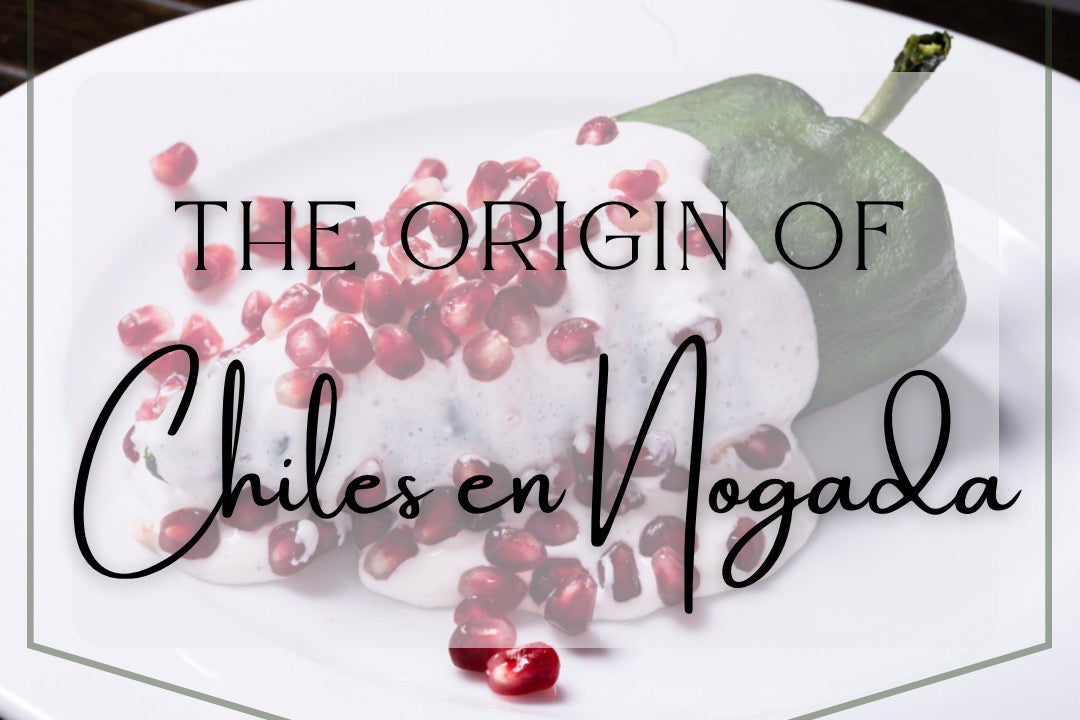September has arrived, and with it comes Mexico’s national month of independence (in which, in 1810, the War of Independence began to free the country from Spanish rule). This, for all Mexicans, is a great occasion to indulge in some of the most exquisite dishes that Mexican cuisine has to offer. One of these typical dishes is chiles en nogada, a classic in Mexican food that tells us about tradition, cultural heritage, and our history as a country.

There are several versions of the creation of the famous chiles en nogada. Today we share with you one of the most well-known stories, which takes us back to 1821, with the culmination of the Mexican War of Independence.
Chiles en nogada is a dish full of history and flavor. It is prepared with stuffed poblano chile, usually with meat and fruit, covered with the main ingredient, the Castilian walnut cream, parsley, and pomegranate that, together, symbolize the three colors of the Mexican flag (green, white, and red).
The dish's roots can be traced back to the Viceroyalty of New Spain. At that time, the court of New Spain celebrated important occasions with lavish and abundant banquets of at least 14 courses; and it was the nuns who were in charge of these banquets, who on each occasion came up with new dishes to surprise the guests, their specialty being desserts.
It is said that in August 1821, when the insurgents were on their way to Córdoba, Veracruz to sign the Act of Independence, the Bishop of Puebla learned that future Mexican emperor Agustín de Iturbide would cross the city on his way and would spend his Saint's day there, for which he decided to welcome him with an impressive 14-course banquet, which included the finest dishes of Puebla cuisine, prepared by the city's convents.
The Augustinian nuns of the Convent of Santa Mónica modified a recipe for stuffed chiles in castilla walnut cream dessert for this banquet. It was intended to celebrate the Independence of Mexico and as a tribute to Agustín de Iturbide. They, impressively, took advantage of seasonal ingredients to create this beautiful work of art, a composition that later became one of the most representative dishes in Mexico.
When the dish was offered to the independents, it became immensely popular. However, as the economy in the country did not allow large feasts, mealtimes had to be reduced and the chile en nogada stopped being a dessert and became a main dish when meat was added to the fruit filling.

Now, I invite you to imagine the flavor of a picadillo combined with fresh, crystallized, dried, and brined fruits mixed with tomato sauce… This stew will be the filling of the poblano peppers, previously roasted, deveined, and peeled. To later be fried in beaten egg and drenched in a rich and creamy walnut sauce that is topped with the sweet and sour grains of pomegranate and parsley. A truly magical experience if you have never had a chile en nogada.
Let us add a point of great controversy: some say that the traditional chile in nogada must always be coated with egg and fried, which will allow it to better absorb the walnut or nogada sauce and that, since it is a baroque dish, we cannot skip any steps in its preparation to truly taste its authentic flavor.
Nowadays, however, in some restaurants you can order the chile without its coat; most even offer it this way either to reduce the amount of fat in the preparation or to please specific palates. At the end of the day, both versions are delicious, always bearing in mind that what they are eating is a modern variant that has been largely popularized.
The fame of chiles en nogada has widely spread throughout the country and around the globe. However, this is a seasonal dish with ingredients such as walnuts and pomegranates that can only be found during the last days of July and until mid-September.
And it is this temporality that also enhances the fame of our very Mexican dish, where we must wait patiently for a whole year to delight our palate again with a portion of Mexico’s history that is served in Talavera poblana dishes and that tastes better in the dinner table surrounded by our loved ones.
Though, it is not an extremely difficult dish to prepare, making chiles en nogada does require commitment and preparation: from finding all the ingredients to making sure the sauce is top-notch. However, if you are looking for a substitute to prepare for these September Mexican celebrations, don’t forget to check out our Chiles Rellenos Recipe!
-
What do you think? Have you ever tried chiles en nogada? What was your experience like? Did you know the history behind their creation? What other dish would you like to learn more about? Let us know in the comments below, we are always delighted to read what you have to say!
Also, don’t forget to check out our Kitchen collection, we have that special touch you are looking for in tabletops, linens, and serveware to celebrate Mexican Independence Day! Don't forget to subscribe to our mailing list so that we can continue sharing all the love!









1 comment
Francis Sevillano
I had them once here in Los Angeles, and it was a very delightful experience.
never had heard of them before, but I know the Cheff of the restaurant “La Villa Cafe” and he recommended the dish, so it was a surprise for me. Can’t wait to try them in Mexico City.
Delicious !!!